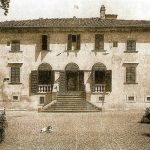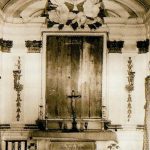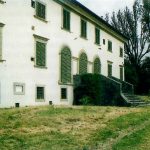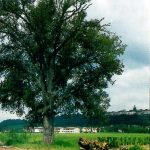The locality is situated downstream from Laterina, immediately south of the provincial road, in the broad flat area between the Bregine stream and the Arno River.During the Middle Ages and the Renaissance, this area was characterized by vast marshes and secondary riverbeds. The Manieri and Berti families owned properties here. In the 17th century, these lands were acquired by the Corboli family, originally from Badia d’Agnano in the Val d’Ambra. The Corboli built a “country house” and a farm on the estate.
In 1709, Sinibaldo Corboli, son of the knight Filippo, erected a chapel dedicated to the Holy Family. Externally, it is characterized by a lintel portal, topped by a Doric “Lucifer” window and the marble coat of arms of the Corboli family (a noble emblem also found on the left plinth of the altar). The chapel is flanked by two small windows with iron grilles.Internally, it features an altar on corbels, framed by composite pilasters supporting a broken pediment. Within the pediment, there is a dove representing the Holy Spirit, surrounded by a golden rays halo, as well as some cherub heads among clouds in white stucco. Beneath the altar is a dedication plaque.
(«SACELLUM HOC / D.O.M. / QUI UNIGENITO FILIO SUO / ET MARIA VIRGINI GENITRICE/ EIUSQUE VIRO SANCTO JOSEPH / QUORUM CONVERSATIO APUD ALTISSIMUM / HIC ADORATUR / IN PERENNE PIETATIS MONUMENTUM / SINIBALDUS CORBOLI EQUITIS PHILIPPI FILIUS / TALITER CONVERSANTIUM CUM SUIS OMNIBUS CHRISTI FIDELIBUS / SOCIUS EFFICI CUPIENS / AD MDCCIX D.D.D.)
In 1756, the Corboli family sold the “country house” of Isola, along with the “workers’ houses” and the various lands dependent on it, to Giovanni di Andrea Ginori. Starting in 1757, Ginori began a comprehensive reclamation of the plain and a radical restructuring of the estate, building new and more rational farmhouses.Some members of the Ginori family are buried in the chapel (Francesco Ginori, who died in 1827, and Anna Gerini Ginori, who passed away in 1841). In 1846, the Ginori family sold the farm, with its twenty-five estates, to Leopold II, and it became part of the Grand Duchy of Tuscany’s Laterina estate.
After the annexation of Tuscany to the Kingdom of Italy, in the 1860s, the estate was purchased by the English geologist, wealthy entrepreneur, and refined collector Francis Joseph Sloane (1795-1871). Sloane arrived in Tuscany around 1824 as secretary and librarian to Count Demetrius Petrovich Boutourline. By 1848, he had become the owner of the Medici villa at Careggi, near Florence, and he was the financier of the new facade of the Florentine basilica of Santa Croce (1854-1863), designed by Niccolò Matas. In 1871, the estate of Isola, along with the villa at Careggi, passed to Count Augusto Boutourline, whose tutor had been none other than Sloane.
The villa was renovated in the second half of the 19th century, taking on a solid and linear parallelepiped shape. Its southern façade is characterized by three arched French doors, equipped with green Livorno-style shutters, preceded by a central stone staircase.Around the villa, Sloane, as he had already done in Careggi around 1853, redesigned the park. To the north, between the building and the Old Aretina Provincial Road (possibly pre-existing), he created a dense woodland, along with numerous new exotic trees in the style of the time (Lebanon cedars, Atlas cedars, pink horse chestnuts, Spanish firs, and evergreen sequoias), some of which were even imported from outside Europe.
A straight avenue, lined with rose and lilac plants as well as imposing cork oaks, extended from the villa to the Bregine stream. A second avenue led to the entrance gate to the west, framed by two stone pillars. Immediately to the west of the villa, at the edge of the wilderness, a large greenhouse was erected to store the lemon pots and other potted flowers during the winter season.The Isola villa-farm was the center of a vast estate, bordered to the east by the neighboring Monsoglio estate. To this day, several families, such as the Margiacchi family, who have been linked to the Isola estate for generations, still depend on the farm.








